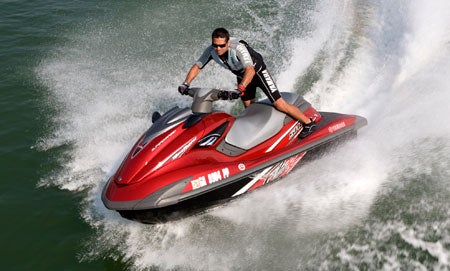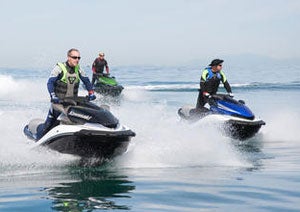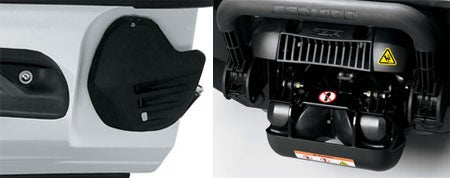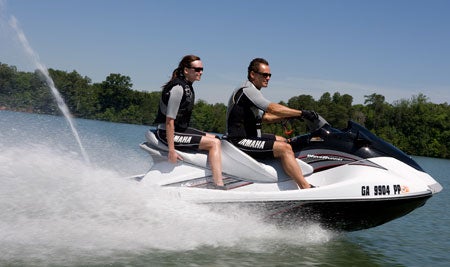Things to Consider Before Letting a Friend Ride Your PWC
Don't just hand over the keys
Showing up at the beach or family gathering with a PWC in tow makes you a pretty popular person for obvious reasons. But it also brings up a delicate situation — friends, relatives, even near-total strangers may ask to try your craft. Say yes and you’ll make their day, but you also may ruin yours.
Thinking of loaning your craft to a friend? Here are five things you should think about before saying “yes.”
Think…Twice!
My father used to say if they have the nerve to ask, you can have the nerve to say no. We’ve all had that borderline friend or acquaintance who asks to ride our craft, or even a good friend who we may fear may not treat it as we would like. Think twice before saying yes to a ride. Once they’re on the water, you can’t control their actions. A good rule of thumb? If you wouldn’t loan your car, motorcycle, or boat to the person in question, don’t lend your PWC.
 It’s dangerous to assume that everybody can handle a powerful craft like Yamaha’s FZR.
It’s dangerous to assume that everybody can handle a powerful craft like Yamaha’s FZR.Teach the Basics
 Make sure you explain the rules of the road, especially if the waterways are crowded.
Make sure you explain the rules of the road, especially if the waterways are crowded.Don’t assume that since operating a PWC is second nature to you it will be likewise to your friends. Show them the basic operation, including handlebars, throttle, and if available, reverse. Explain how a PWC works, how it will handle in a turn, and where all the vital controls can be found.
Emphasize that a PWC needs thrust to maneuver; novice riders tend to let off the throttle in panic situations, rather than use it to maneuver away. It’s also a good idea to go over how to approach a dock, as well as basic rules of the road for boaters.
Other suggestions? Tell your drivers to look over their shoulders before they make a turn to make sure there’s no traffic alongside or coming up from behind, and to leave a generous amount of room between themselves and any other traffic on the water.
Go Over Additional Safety Features
Does your craft have braking, or off-throttle steering? Explain how they work, when to use them, and what the rider should expect during their operation. Still, caution that, as good as they may be, these features are still no replacement for an alert, responsible, defensive driver.
 Less experienced riders would benefit from knowing about safety features like Sea-Doo’s OPAS (left) and intelligent braking (right).
Less experienced riders would benefit from knowing about safety features like Sea-Doo’s OPAS (left) and intelligent braking (right).You might also want to consider using manufacturer-provided throttle-limiting devices, like speed-governing lanyards, keys, or codes, especially with total newcomers, to keep speeds under certain limits.
Discourage Amateur Mechanics
Should something go wrong, teach your riders how to use safety devices — an air horn, whistle, signal flag, or VHF radio — but advise them to avoid any well-intentioned tinkering. From water intrusion into the hull to messing up any number of engine settings, bad things can go wrong when friends try to help.
If something does go wrong, advise them to stay with the boat and signal for help.
Consider Your Liability
Remember, no matter who’s at the controls, that’s your craft under someone else’s control. It could be damaged, or worse, cause damage or injury to someone else or someone else’s property. Again, think twice about who your real friends are and who you trust with a quick-accelerating, very-fast motorized vehicle in a riding area that has no striping or road signs to keep traffic funneled in a safe direction.
 Riding as a passenger when you loan out your craft is a good way to gauge somebody’s ability.
Riding as a passenger when you loan out your craft is a good way to gauge somebody’s ability.The good news is that from an insurance standpoint you should be covered in the case of any accidents, as long as your operator doesn’t cause intentional harm. Typically, PWC insurance is like auto insurance in that the coverage follows the vehicle.
Just make sure the driver has your permission. And don’t try to get cute and “rent” your boat; that requires a commercial operator’s license and will void the coverage.
Get PersonalWatercraft.com in your Inbox!
Like PersonalWatercraft.com on Facebook
Comments
Most Popular

2025 Yamaha JetBlaster PRO 2-Up Review

2024 Kawasaki Jet Ski STX 160X Review

Remembering the Sea-Doo XP

Whatever Happened to the Wetbike?

2025 Yamaha JetBlaster Review











 Your Privacy Choices
Your Privacy Choices